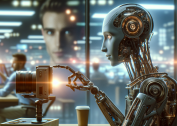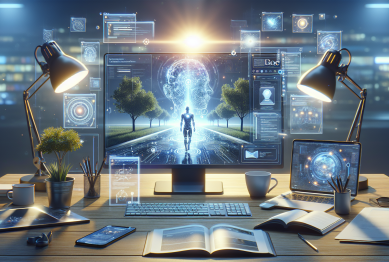Artificial intelligence is transforming the way people live, work, and connect. Discover the unexpected ways AI influences daily life—from smart devices to healthcare, ethical debates, and future trends—in this practical and informative guide brimming with real-world examples.
AI in Everyday Devices
Artificial intelligence, once a concept limited to futuristic movies, is now embedded in countless everyday technologies that most people use. When smart speakers recognize voices and adjust home settings, or smartphones present personalized suggestions, AI is actively at work. Devices like virtual assistants, adaptive home thermostats, and even spam filters for email rely on complex machine learning algorithms to streamline daily routines. These innovations show how AI isn’t just about automating tasks—it’s about anticipating needs and making life easier. People don’t always realize how much artificial intelligence influences the tools they trust every day.
Voice recognition is one of the most visible applications of AI in household technology. Smart assistants like Siri and Alexa understand natural language queries and convert them into actions by leveraging vast neural networks. Behind the scenes, these systems rapidly process speech, recognize intent, and pull relevant information from the cloud. In addition, predictive text and autocorrect features in messaging apps are powered by natural language processing models. By analyzing billions of typed words, AI helps people communicate more efficiently—even catching common mistakes before messages are sent.
Smart home devices extend AI’s reach even further. Thermostats like Google Nest learn family routines and adjust temperatures based on weather patterns and user preferences. Security systems analyze movement and sound to distinguish between a pet and a possible intruder. The underlying technology draws from fields like pattern recognition and real-time data analytics, ensuring homes become more energy-efficient and safer. These examples reveal just a few of the many subtle ways that AI has integrated itself into household routines.
Healthcare Advances Driven by Machine Learning
The influence of artificial intelligence in healthcare is profound and growing every year. Algorithms now assist radiologists by spotting subtle patterns in X-ray and MRI scans that might escape the human eye. With advances in computer vision, automated systems can flag possible illnesses early—sometimes before symptoms appear. Hospitals deploy AI-powered scheduling systems to optimize doctor assignments and resource allocation, improving patient wait times and boosting overall care quality.
Machine learning also plays a pivotal role in personalized medicine. By analyzing vast datasets of patient histories, genetics, and lifestyle factors, AI models can recommend individualized treatment strategies. For example, cancer therapies are increasingly tailored to genetic markers identified by AI algorithms in research labs. These breakthroughs have made treatments more effective and reduced unnecessary interventions, enhancing the quality of life for many individuals who face chronic illnesses or complex diagnoses.
Another vital area impacted by AI is remote health monitoring. Wearable devices continuously track heart rate, sleep patterns, and physical activity, using AI to identify early warning signs of disease. When readings deviate from healthy baselines, automated alerts can notify both users and medical professionals. By enabling earlier interventions and more accurate diagnoses, AI-powered tools support a shift from reactive to proactive healthcare, making advanced medicine more accessible to many communities.
Behind the Scenes in Social Media and Content Recommendations
Social media platforms and streaming services depend heavily on artificial intelligence to curate what people see—and don’t see—when browsing online. Every time someone clicks ‘like’ or pauses on a photo, AI algorithms are at work, building profiles and predicting what will keep viewers engaged. These systems power personalized news feeds, video recommendations, and trending topic lists, ensuring millions of users enjoy experiences tailored to their interests. However, the same technology that provides convenience can also contribute to the creation of echo chambers and filter bubbles.
Content recommendation engines rely on deep learning, a branch of AI that mimics the structure of the human brain. By analyzing large datasets of behavior—such as clicks, searches, and viewing patterns—these models anticipate what users might enjoy next. The technology enables platforms like YouTube, Netflix, and Spotify to continually suggest content that feels uniquely relevant. Over time, deep learning models can adapt to shifting preferences, keeping recommendations fresh and engaging for individuals as their interests evolve.
AI’s influence on personalized recommendations brings both benefits and challenges. While it streamlines access to information, it also raises questions about information diversity and potential bias. Researchers and technologists are now working to refine these algorithms, introducing new mechanisms for transparency and user control. By understanding the strengths and pitfalls of AI-powered social platforms, users can make more informed decisions about what they consume and share online.
Ethics and Challenges: Navigating Tomorrow’s Technology
The rapid expansion of artificial intelligence raises important questions about ethics, privacy, and bias. As algorithms take on roles in hiring, lending, or criminal justice, the risk of unintentional discrimination can increase unless systems are carefully designed and regularly audited. AI models reflect the data used to train them; when historical records contain bias, outputs may unknowingly reinforce it. This has led to global conversations about the fair and responsible deployment of technology on every level.
Privacy remains a major public concern as AI becomes more complex and ubiquitous. Devices constantly collecting data—whether for voice commands, health metrics, or browsing habits—bring the potential for inadvertent exposure if not properly secured. Tech companies and legislative bodies now collaborate to draft frameworks for ethical AI development and data protection, aiming to keep individuals’ information private while enabling innovative progress. The challenge is to balance innovation with respect for users’ rights and the values of diverse societies.
Transparency and explainability are crucial when deploying AI across sensitive industries. People increasingly expect to understand how decisions are made, whether it’s an automated credit score or a flagged social media post. Enhancing algorithmic transparency not only builds trust with the public but also helps engineers identify and correct potential flaws. As society adapts to the presence of AI, robust accountability measures and open conversation are essential to ensure these systems work for everyone—not just a select few.
The Future of Artificial Intelligence and Personal Impact
Looking forward, trends suggest that artificial intelligence will only become more integral to personal and professional life. Continual advances in computation and neural networking point to even smarter personal assistants, enhanced predictive healthcare, and smarter transportation options. Researchers are exploring explainable AI and new skills for machines that could support complex decision-making, collaboration, and creative thinking. The evolution is happening quickly, with direct implications for many fields—education, logistics, and environmental science among them.
While the potential of AI is immense, the technology is still developing. Emerging innovations such as natural language generation, generative art, and real-time translation open opportunities but also demand careful stewardship. It’s likely that people will increasingly work alongside intelligent systems, blending human intuition with algorithmic guidance. Preparing for these shifts involves continuous learning, digital literacy, and openness to collaboration across cultural and sector boundaries.
Some of the most promising developments involve using AI to address society’s biggest challenges. Projects focused on climate modeling, renewable energy management, and improved accessibility give a glimpse of how technology can drive positive change. As more organizations focus on ethical and equitable AI deployment, the goal remains clear: harness intelligence to amplify human potential, supporting healthier, fairer, and more sustainable communities worldwide.
References
1. U.S. Food & Drug Administration. (n.d.). Artificial Intelligence and Medical Devices. Retrieved from https://www.fda.gov/medical-devices/software-medical-device-samd/artificial-intelligence-and-medical-devices
2. European Commission. (n.d.). Ethics guidelines for trustworthy AI. Retrieved from https://digital-strategy.ec.europa.eu/en/policies/ethics-guidelines-trustworthy-ai
3. MIT News. (2021). The future of AI: Toward truly intelligent machines. Retrieved from https://news.mit.edu/2021/future-of-artificial-intelligence-0120
4. World Health Organization. (2021). Ethics and governance of artificial intelligence for health. Retrieved from https://www.who.int/publications/i/item/9789240029200
5. Brookings Institution. (2023). Reducing bias in AI. Retrieved from https://www.brookings.edu/research/reducing-bias-in-ai
6. Pew Research Center. (2022). AI and Human Enhancement: Americans’ Openness Is Tempered by a Range of Concerns. Retrieved from https://www.pewresearch.org/internet/2022/03/17/ai-and-human-enhancement-americans-openness-is-tempered-by-a-range-of-concerns/









